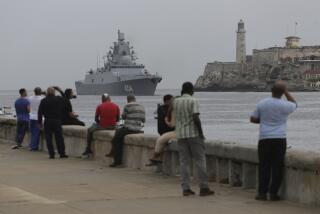Nuclear Fears: In Cuba, Russia--and at Home : It pays to reduce the risk of accident--and sabotage
- Share via
The molten core of Chernobyl, the wrecked nuclear power plant in Ukraine, has been aptly called a “nuclear volcano.” It will remain a threat to human life for as long as the human species survives. Another Chernobyl or, worse, a series of Chernobyls is among the worst imaginable environmental disasters.
For this reason, it is good news that on Jan. 29, the Group of Seven industrial powers agreed to create an emergency fund to improve safety at the nuclear power plants of the former Eastern Bloc. France and Germany will contribute $80 million together. Japan and the United States have not yet stated their commitment, but it may be that much or more. The funding falls short of the $700 million that the Munich G-7 summit last July proposed, and further short of what is required; but with luck, the worst disasters in the making may be caught in time.
The uncertain legal liability entailed in making Western repairs to Eastern reactors that then might fail anyway has retarded this crucial rescue mission. So has the desire of the Americans and Japanese for separate rescue missions and a larger share of the resulting business. Fortunately, the G-7 negotiators have now managed to get past these roadblocks.
Of particular concern to Americans are two nuclear power plants due to come on line at Cienfuegos, Cuba, in 1995 and 1997, respectively. While the G-7 summit was in progress last summer, the Heritage Foundation issued a sobering report based on testimony by two Cuban defectors, senior nuclear engineers who had worked at the plants, which lie just 250 miles from Miami. The plants are both of the accident-prone VVER-440 Soviet design. Worse, both have been plagued by what the engineers described as appallingly slipshod construction.
A meltdown in Cuba would obviously be a political as well as an environmental catastrophe for the United States. The Clinton Administration, to its credit, is already concerned about the consequences for the United States of chaos in Cuba. One hopes that when Fidel Castro passes, the communist regime there will pass with him. But it is conceivable that, if his regime lasts till 1995, its end may be hastened, as the end of the Soviet regime arguably was, by nuclear catastrophe.
The United States, obviously, should do everything it can to prevent that most traumatic of imaginable transitions. And one thing it can do is channel to Cuba some of its contribution to the new G-7 fund.
Ironically, the fear is seriously entertained in Washington that an embattled, panicked Castro might strike at the United States by attacking a power plant in Florida. How would such an attack occur? Don’t look now, but on Feb. 7, a former mental patient crashed his station wagon through the front gates at Three Mile Island. Had this been a car-bomb terrorist, the infamous bomb destruction of Marine headquarters in Beirut could have been duplicated in Pennsylvania.
After the Beirut atrocity, measures were taken to prevent anything comparable at the White House. But the Nuclear Regulatory Commission has rejected proposals by the Committee to Bridge the Gap and the Nuclear Control Institute to introduce such protection at U.S. nuclear power plants. Those proposals should be revived. We need to be on guard not just against accident but also against sabotage.
More to Read
Sign up for Essential California
The most important California stories and recommendations in your inbox every morning.
You may occasionally receive promotional content from the Los Angeles Times.










